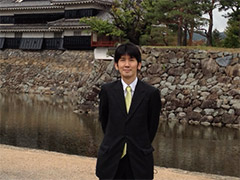A motivation like no other
By Betty Zou
For Dr. Teppei Noda, the research is deeply personal. Noda, who is a postdoctoral fellow in the lab of Dr. Alain Dabdoub in the Hurvitz Brain Sciences Research Program at Sunnybrook Research Institute (SRI), studies the complex processes leading to the formation and development of the inner ear. The questions he pursues each day are especially relevant because he is severely hearing impaired.
Noda was five years old when he first realized he had trouble picking up the chatter of his playmates and instructions from his parents. As a schoolboy in the Japanese city of Nagasaki, he compensated by sitting in the first row in class. By the time he was 19, his hearing had worsened to a point where he needed hearing aids. “Even in my primary language of Japanese, I have difficulties at conferences or in conversations with many people,” says Noda. “I wanted to do research and study hearing regeneration because of my hearing loss.”
Strongly motivated, he obtained his MD in 2005, specializing in otology, head and neck surgery. He then completed his PhD in 2012. In his PhD, he discovered the role of the Wnt signalling pathway in the formation of semicircular canals, three interconnected tubes in the ear that serve as the body’s balance organ. Problems at the canals can lead to balance disorders, which includes difficulties standing or walking in a straight line, vertigo and hearing loss. When it came time to choose a lab for his postdoctoral training, he decided Dabdoub’s lab was a perfect fit.
As director of the Sonja N. Koerner Hearing Regeneration Laboratory at SRI, Dabdoub runs Canada’s only research program dedicated to finding biological solutions for hearing loss. He is particularly interested in how the Wnt signalling pathway influences sensory hair cell and auditory neuron development. Sensory hair cells pick up sound vibrations and turn them into electrical signals for auditory neurons to transmit to the brain. These cells cannot regenerate; therefore, if they are damaged, for example by infection or noise, they are gone forever.
Today’s strategies to treat hearing loss are device-centric—hearing aids and cochlear implants can improve hearing for patients but do not address the underlying biological causes of impairment. With a better understanding of how the Wnt signalling pathway commands cells to become sensory hair cells or auditory neurons, Dabdoub wants to be able to develop biological therapies that can trigger cell regeneration, thereby restoring normal function to the inner ear.
Noda’s work is focused on auditory neuron regeneration and how the Wnt signalling pathway turns genes on and off at different stages of sensory hair cell development. While his projects fall under the realm of basic research, he says he sees a lot of potential for his findings to translate to clinical impact in the future. “Each result doesn’t have a lot of impact by itself but it’s important to connect [this work] to clinical research,” he says. “I’m constructing the basement of [that clinical] research.” After his postdoctoral fellowship, he wants to go back to Japan and start his own laboratory at Kyushu University to continue researching hearing regeneration.
In addition to his experiences, Noda is driven by the patients he sees in his clinical practice. “I saw many children with hearing loss, and it was very difficult to treat them,” he says. “I talked about my hearing loss to the patients and their parents. I can understand them.”
Noda is the recipient of a fellowship from the Uehara Memorial Foundation and the Harry Barberian Scholarship. Dabdoub’s research is supported by the Canada Foundation for Innovation, Hearing Foundation of Canada, Hearing Health Foundation, Hearing Regeneration Initiative at Sunnybrook, Ontario Ministry of Research and Innovation, and Michael and Sonja Koerner.






